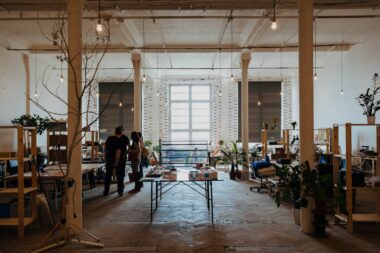Space heavily influences our well-being and our performance – this has been nothing new for a long time. Also, the fact that activities require different environments has gotten around; hence we no longer spend the whole day at our work desk.
Future-oriented companies try to integrate the needs of their employees and the requirements of the organization into the design of work environments. A trend in current office design has been going on for years: Activity-based Working (ABW) and the associated shared or clean desk policies. Apart from the dubious feasibility (e.g. what measures are taken if an employee violates the clean desk policy?; and are they proportionate?) and the fundamental consideration of whether it is actually clever not to allow employees create an identity in their workplace (think about family photos), a big question arises: is Activity-Based Working really the answer to the future challenges of companies?
“Blocked? Play table tennis! Get some sushi! When you’re tired, relax in the nap room . […] The workplace is increasingly designed to be as supportive as possible, resembling more and more very expensive private schools. Today, offices are being trimmed into supportive spaces at a very high cost, and are taken as models for “innovation zones”, as if the principle were valid: the nicer the environment, the more creative the people.”
Richard Sennett, Building and Dwelling [translation from German into English by the author of this text]
Activity-Based Working Is Not Enough
We – and many of our customers – see things differently. Yes, Activity-Based Working mobilizes employees to look beyond their desks, but most of the time they still stick to their unconscious routines and thought patterns – they still do the same things, just in different places. Activity-Based Working is based on the – mostly individual – needs of the employees, the needs of the team and the company often fall behind. Individual well-being takes precedence over the common good.
Interdisciplinary work is the key to success
Future-oriented companies should therefore not primarily promote Activity-Based Working, but interdisciplinary and project-based work. Very different and challenging requirements have to be reconciled: The content of the project, the complexity of the task, the needs of the customer, the time schedule, the ability to plan, the perspectives of the stakeholders, the project structure, etc. – all these parameters require a precisely coordinated room setting, which in most cases must “evolve with the project”. The leitmotif here is always: The project is in the foreground, it sets the rhythm, and the space around the project must be able to change “fluidly” (quickly, uncomplicatedly, according to the project’s needs, etc.).
Project islands as a location for interdisciplinary work
One of our clients, a successful European real estate developer, was also confronted with these challenges. The complex real estate projects are implemented over a period of 3-5 years, with a wide variety of internal and external stakeholder groups working together on one project, at changing intervals. A creation process lasting several months is followed by a construction phase, stretching over several years, which is followed by open-ended asset management. There are several critical points in the life cycle of such a project, especially in the case of handovers from one project phase to the next.
- For example, the concept (the “value proposition”) of the project is not explained to later project participants, which often results in special design ideas falling victim to budget cuts;
- important functionalities (keyword: underground car park) in the building are misplanned;
- or changing user needs are not included in a user experience design.
The fact is: Nobody can consider all these aspects alone; it takes the ability to combine different perspectives as an interdisciplinary team to create a coherent product.
So how can we design work environments that support complex projects by facilitating productive and consistent teamwork?
Together with our client, we have developed so-called “project islands”. However, we did not deal with the architectural dimension first, but started by exploring the following questions, i.e.:
- Where does the company want to go? What strategy does it pursue?
- What role do projects play in achieving this strategy? Are they driving the company’s success?
- How are projects being managed in this specific company?
- Which stakeholders are working together at which point in time? What is their role?
- Keyword matrix organization: How do the project teams differentiate themselves from the rest of the organization? Where are the interfaces that should be considered? Because: the solution must work for the project team, but also for the company as a whole.
We have developed, described, and illustrated the insights gained from this first step into a master plan for the project islands:
- Organizational design concept: How do we have to work in the future in order to achieve our goals in the best possible way? Which organizational processes and structures work well and should be strengthened? Where are there bottlenecks, where is information getting lost? What is missing? Which governance structures, routines and practices should be established?
- Design brief: How should the project islands be designed (design principles, core functions, design and size of work stations, location in the overall work environment, flexibility, vertical/horizontal surfaces, IT support, etc.)?
- Change approach: Do employees understand what is expected of them? Can they identify themselves with the direction of the company? Do they have the necessary attitudes and skills? When and how can they be involved in the design process? How do we support the project teams and individual employees in making the necessary changes?
Our experience is that most employees want to make a valuable contribution to the company and usually make good suggestions as to how project work can be supported – organizationally and spatially. That is why we always develop work environments together with the people who will use them. However, we don’t aim at defining the “perfect working environment” (because there is no such thing). Instead, we start with a “functional prototype”, which is then tested and further developed in different work settings over a longer period of time. We leverage a wide range of change methods and tools that are being adapted to the specific context of the company. Independently of this, however, a co-creative design process requires the following attitudes and skills of the actors involved:
- Ability to change perspective: Stakeholders involved in the design process must be able to empathize with the ways of thinking and „world view“ of others.
- Ability to become aware of one’s own assumptions and to suspend them.
- Ability to talk about one’s own assumptions and those of others.
- Ability to see the big picture and to put aside one’s own preferences or wishes in favor of the team and cooperation.
- Clarity about one’s own role and the contribution to the big picture as well as an understanding of the roles of other stakeholders.
The next step of our project with the real estate developer was to work with the users of the project islands to (i) define organizational constraints, (ii) design and prototype work settings, and (iii) develop a common understanding of future team work as well as a “handbook” for project work.
A game changer in the successful implementation of the project islands proved to be an extended prototyping phase: a project team of about 5 people volunteered to work in a test setting over a period of 2 months: in a newly designed work environment, with new work processes and “at distance” from their departments – in order to learn quickly what the advantages and challenges of the new work space and modus operandi are and to communicate this to their colleagues at first hand and in a credible way.
At the same time, we developed a project handbook in collaboration with about 50 people from various parts of the company. The handbook describes and visually summarizes the most important cornerstones of project work: what is the strategy of the company and what role do projects play? How does a project get realized (phases, milestones, deliverables, etc.)? Who are the most important project participants, what are their responsibilities? How is project work happening: processes and structures, space (project islands) and concrete team practices?
The furniture of the project islands was planned together with the client and manufactured in cooperation with a local carpenter, the organizational framework and the concrete team practices were developed together with the prototyping team and their peers, in order to make sure that the employees would get a holistic understanding of the new way of working.
We always choose an integrative, holistic approach for change projects, because: a good work setting is not achieved by chance, but too rigid planning prevents employees from taking responsibility for their working environment from the outset.
As for our real estate client, employees did not experience the day of moving into the new working environment as a break between the familiar and the unknown, but as the next step in a joint learning and development process. This was also promoted by the fact that their new work space was not completely furnished, but that they could “occupy” the room together: tables were moved, functional transitions from one project island to the next were discussed, screens, room dividers, etc. were positioned in such a way that the greatest possible user-friendliness was guaranteed for everyone. In this “negotiation process”, social contracts were jointly defined, an experience which can be described as quite similar to getting to know one’s “new neighbors”.
Over the next few months, together with the “inhabitants” of the project islands, we further developed the space, the furniture and the work processes; in addition, a “growth plan” was elaborated, as other departments of the company also showed interest in project-based working. Of course, this “maturing process” did not run smoothly, but the basic idea of the project islands – interdisciplinary work in which the focus is not on individual well-being but on a higher organizational purpose – was never questioned.
Feedback from “residents” of the project islands, 3 weeks after moving into the new work setting:
- The project islands make life easier for the project managers and promote the mindfulness of the team members.
- There is a fruitful exchange between the different project islands.
- Short distances enable quick decisions and create a “good mood”.
- The project islands are the information hub for the projects: plans, mock-ups, and renderings, budgets, and milestones – everything is displayed in one place.
- The project islands change their appearance: in the beginning, they were “rough”, now they are very visual and colorful. The project islands grow with the projects.
From our experience in this and many similar projects, we can say: interdisciplinary work is one of the greatest challenges – and one of the greatest potentials – for future-oriented companies. There is no recipe for what project islands should look like – the physical appearance is important, but only at a later stage. At the beginning, it is important to work out what significance such a kind of work has for the respective industry, a certain team and the company. This varies from sector to sector and from company to company. Designing a project-oriented work environment requires a well-thought-out and detailed master plan which integrates organizational requirements, spatial settings, and team practices and which can be co-designed and further developed by the employees.
The project islands – or similar interdisciplinary work settings – thus can become the culmination point of a new identity and a place for meaningful work.
Image: Michael Baccin at Unsplash
Subscribe to Our Newsletter
Keep your innovative edge with more stories like this and additional reading tips, muses, and project updates.


